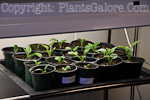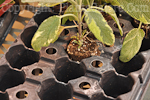Commonly
grown annual flowers and
vegetables are usually very easy to
start from seed. Just pop them into a sterile media such as
perlite or
vermiculite and keep them moist and warm. Before
long, little seedlings will be sticking their heads up looking
for the light.
 Many
seeds from perennial plants are just as easy to start. Pop
them into the medium and they come up in a few days or weeks.
However, the seeds of some flowering
perennials and most
species of trees and
require special care. These plants
originated in regions that presented unique climate problems
that had to be overcome. Depending on the "coping mechanism"
adapted by the plant, these seeds require special treatments
before they will germinate.
Many
seeds from perennial plants are just as easy to start. Pop
them into the medium and they come up in a few days or weeks.
However, the seeds of some flowering
perennials and most
species of trees and
require special care. These plants
originated in regions that presented unique climate problems
that had to be overcome. Depending on the "coping mechanism"
adapted by the plant, these seeds require special treatments
before they will germinate.
 The most common seed treatments are
stratification and scarification. Many species originated in
deciduous forests where seeds drop to the ground and are
covered by leaves in the fall. They spend the winter encased
in this moist, cool environment before germinating in the
warm, moist conditions of spring. The embryo inside such seed
is immature and unable to grow until it has been nurtured in
this manner. This delayed germination is vital to the survival
of the species. The seeds are set in the autumn. If they
germinated immediately after falling to the ground, the tender
seedlings would be killed by the winter cold.
The most common seed treatments are
stratification and scarification. Many species originated in
deciduous forests where seeds drop to the ground and are
covered by leaves in the fall. They spend the winter encased
in this moist, cool environment before germinating in the
warm, moist conditions of spring. The embryo inside such seed
is immature and unable to grow until it has been nurtured in
this manner. This delayed germination is vital to the survival
of the species. The seeds are set in the autumn. If they
germinated immediately after falling to the ground, the tender
seedlings would be killed by the winter cold.
 Stratification
is the process of simulating nature by exposing seeds to cool,
moist conditions for a number of weeks or months. Take peat
moss and soak it in water until it is saturated. Then, squeeze
out as much water as possible with your hands. Place a layer
of the moist moss in the bottom of a plastic container. Place
the seeds on this layer and fill the rest of the container
with peat moss. Store it in the refrigerator for 3 to 6 months
depending on the species of plant. Remove the seeds and plant
them in the normal manner.
Stratification
is the process of simulating nature by exposing seeds to cool,
moist conditions for a number of weeks or months. Take peat
moss and soak it in water until it is saturated. Then, squeeze
out as much water as possible with your hands. Place a layer
of the moist moss in the bottom of a plastic container. Place
the seeds on this layer and fill the rest of the container
with peat moss. Store it in the refrigerator for 3 to 6 months
depending on the species of plant. Remove the seeds and plant
them in the normal manner.
Another mechanism used by plants to prevent
their seeds from germinating too soon is the formation of an
extremely hard seedcoat. In nature, these seeds may lay
dormant until weathering action and micro-organisms break
through the hard seed coat. Seeds from a single crop may
germinate over several succeeding years. This increases the
likelihood that at least some of them will emerge under
favorable growing conditions and survive to perpetuate the
species.
To get these seeds to germinate immediately,
the seed coat must first be softened or broken so that water
can penetrate and the seedling can emerge. This process is
called scarification.
 Seeds
may be scarified a number of ways. Nicking the seedcoat with a
file or sandpaper is probably the easiest method. Soaking
seeds in a mild acid solution is often used by commercial
growers. Some seeds may be scarified simply by soaking them in
warm water over-night.
Seeds
may be scarified a number of ways. Nicking the seedcoat with a
file or sandpaper is probably the easiest method. Soaking
seeds in a mild acid solution is often used by commercial
growers. Some seeds may be scarified simply by soaking them in
warm water over-night.
 To determine the requirements of a
particular species, check the seed packet. If you are
collecting seed directly from the plant or got them from a
friend, there are several references which should be helpful.
Park's "Success With Seeds" is an excellent reference for
perennial and annual seed germination. For trees and shrubs,
the USDA's "Seeds of Woody Plants in the United States"
contains the requirements of just about every tree that grows
around here. You can find these at the library or give me a
call since I have both of them on my shelf.
To determine the requirements of a
particular species, check the seed packet. If you are
collecting seed directly from the plant or got them from a
friend, there are several references which should be helpful.
Park's "Success With Seeds" is an excellent reference for
perennial and annual seed germination. For trees and shrubs,
the USDA's "Seeds of Woody Plants in the United States"
contains the requirements of just about every tree that grows
around here. You can find these at the library or give me a
call since I have both of them on my shelf.



